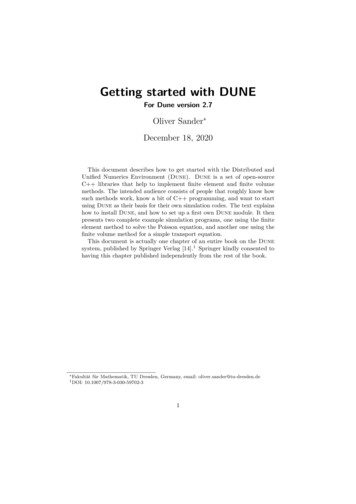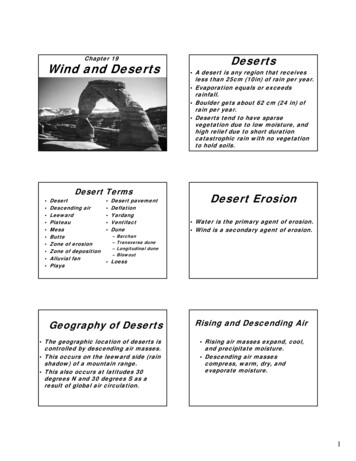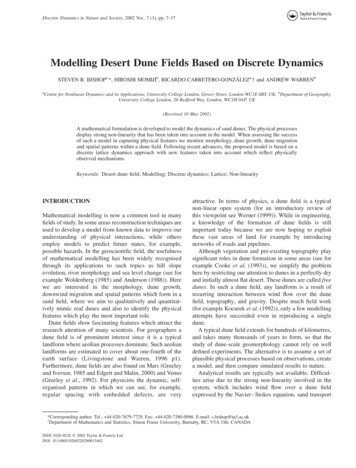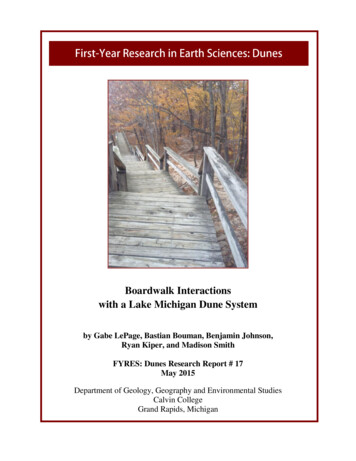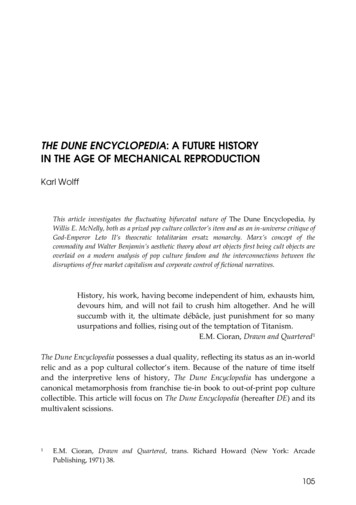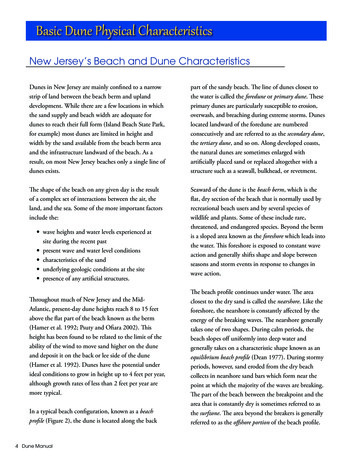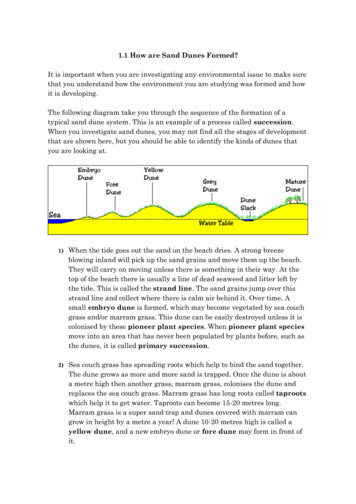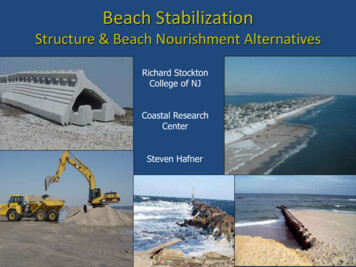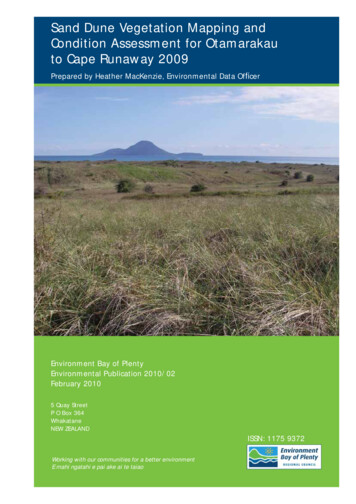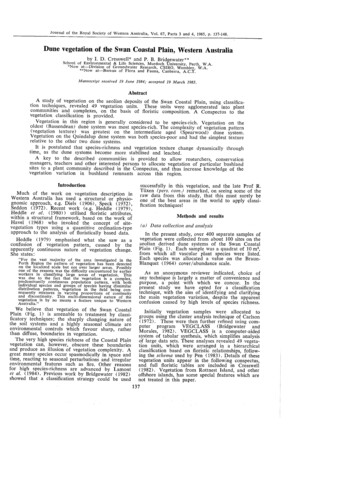
Transcription
Journal of the Royal Society of Western Australia, Vol. 67, Parts 3 and 4, 1985, p. 137-148.Dune vegetation of the Swan Coastal Plain, Western Australiaby I. D. Cresswell* and P. B. Bridgewater**School of Environmental & Life Sciences, Murdoch University, Perth, W.A.*Now at-Division of Groundwater Research, CSIRO, Wembley, W:A.**Now at-Bureau of Flora and Fauna, Canberra, A.C.T.Manuscript received 19 June 1984; accepted 19 1'.1arch 1985.AbstractA study of vegetation on the aeolian deposits of the Swan Coastal Plain, using classification techniques, revealed 49 vegetation units. These units were agglomerated into plantcommunities and complexes, on the basis of floristic composition. A Conspectus to thevegetation classification is provided.Vegetation in this region is generally considered to be species-rich. Vegetation on theoldest Bassendean) dune system was most species-rich. The complexity of vegetation pattern(veget ttion texture) was greatest on the intermediate aged (Spearwood) dune system.Vegetation on the Quindalup dune system was both species-poor and had the simplest texturerelative to the other two dune systems.It is postulated that species-richness and vegetation texture change dynamically throughtime, as the dune systems become more stabilised and leached.A key to the described communities is provided to allow researchers, conservationmanagers, teachers and other interested persons to allocate vegetation of particular bushlandsites to a plant community described in the Conspectus, and thus increase knowledge of thevegetation variation in bushland remnants across this region.IntroductionMuch of the work on vegetation description inWestern Australia has used a structural or physiognomic approach, e.g. Diels 0906), Speck (1952),Seddon (1972). Recent work (e.g. Heddle 0979),Heddle et al. 0980)) utilised floristic attributes,within a structural framework, based on the work ofHavel 0968) who invoked the concept of sitevegetation types using a quantitive ordination-typeapproach to the analysis of floristically based data.Heddle 0979) emphasised what she saw as aconfusion of vegetation pattern, caused by theapparently continuous nature of vegetation change.She states:"For the vast majority of the area investigated in thePerth Region the pattern of vegetation has been detectedon the localized scale but not over larger areas. Possiblyone of the reasons was the difficulty encountered by earlierworkers in classifying large areas of vegetation. Thiswas due to the fact that the vegetation is a complex,predominantly continuous population pattern, with bothindividual species and groups of species having dissimilardistribution patterns, vegetation in the field being consequently mixtures in varying proportions of continuityand discontinuity. This multi-dimensional nature of thevegetation is by no means a feature unique to WesternAustralia."We believe that vegetation of the Swan CoastalPlain (Fig. 1) is amenable to treatment by classificatory techniques; the sharply changing nature ofthe soil systems and a highly seasonal climate areenvironmental controls which favour sharp, ratherthan diffuse, boundaries in vegetation.The very high species richness of the Coastal Plainvegetation can, however, obscure these boundariesand produce an illusion of vegetation complexity. Agreat many species occur spasmodically in space andtime, reacting to seasonal perturbations and irregularenvironmental features such as fire. Other reasonsfor high species-richness are advanced by Lamontet al. 0984). Previous work by Bridgewater (1982)showed that a classification strategy could be usedsuccessfully in this vegetation, and the late Prof R.Ti.ixen (pers. com.) remarked, on seeing some of theraw data from this study, that this must surely beone of the best areas in the world to apply classification techniques!Methods and results(a) Data collection and analysisIn the present study, over 400 separate samples ofvegetation were collected from about 100 sites on theaeolian derived dune systems of the Swan CoastalPlain Fig. 1). Each sample was a quadrat of 10m2 ,from which all vascular plant species were listed.Each species was allocated a value on the BraunBlanquet 0964) cover/abundance scale.As an anonymous reviewer indicated, choice ofany technique is largely a matter of convenience andpurpose, a point with which we concur. In thepresent study we have opted for a classificationtechnique, with the aim of identifying and clarifyingthe main vegetation variation, despite the apparentconfusion caused by high levels of species richness.Initially vegetation samples were allocated togroups using the cluster analysis technique of Carlson( 1972). These were then further refined using computer program VEGCLASS Bridgewater andMorales, 1982). VEGCLASS is a computer-aidedsystem of tabular synthesis, which simplifies analysisof large data sets. These analyses revealed 49 vegetation units, which were arranged in a hierarchicalclassification based on floristic relationships, following the schema used by Pen (1983). Details of thesevegetation units appear in the following conspectus,and full floristic tables are included in Cresswell 1982). Vegetation from Rottnest Island, and otheroffshore islands, has some special features which arenot treated in this paper.137
[Eill]QUINDALUP1::--:: --JSPEARWOODi:::TJ BASSENDEAN0 6KILOMETRESSCALE 1:20 0006
Journal of the Royal Society of Western Australia, VoL 67, Parts 3 and 4, 1985.(b) Conspectus of vegetation unitsVegetation units identifed in the study are describedin this section, from floristic and structural viewpoints. A key to the vegetation units is included asan appendix. This key should enable workers in thefield to identify particular vegetation sites within theregion described.The base unit in the hierarchy is the community,analagous to the association of the Ziirich-MontpellierSystem (Bridgewater 1981). Communities aredivided into sub-communities and variants, andaggregated to form complexes. In most cases subcommunities are named after a distinguishing species.Where a sub-community has the same species complement as that for the community the epithet "typical"is used. Use of the community-complex nomenclature follows that of Pen ( 1983) and should not beconfused with the use of complex by Heddle et al.(1980).For the lowest level of hierarchical division somedistributional and ecological notes are included. Distribution of the vegetation units across the SwanCoastal Plain is shown in Figure 2. Species nomenclature is that of Marchant (in prep.). Specimens ofmost species ·named are lodged with the WesternAustralian Herbarium. Terminology of the geomorphic units used in the text follow Bettenayet a!. 0960).DuneSystemA.Stirlingia latifolia-Oxylobium capitatumcomplexA.l. Dasypogon bromeliifolius-Lyginiabarbata communityA.l.a. Scaevola paludosa sub-communityA.l.a.i. M onotaxis grandiflora variantUsually restricted to the tops of dune ridges inthe Karrakatta soil association. OccasionallyXylomelum occidentale occurs as extensive patches,more or less replacing Banksia species as dominants.A.l.a.ii. Acacia willdenowiana variantLocalised on dune · slopes at the junction betweenKarrakatta and Bassendean soil associations.A.l.b. Hardenbergia compton/ana subcommunityA.l.b.i. Leucopogon propinquus variantLocalised on the upper slopes of dune ridges inthe eastern sector of the Karrakatta soil association.IQUINDALU pSPEARWOODSoilAssociation QUINDALU pAverageSpeciesRichnessTables 1-3 are summaries of species occurrencesin the vegetation units. Identifying species for eachunit are those with presences of 4 or 5 in eachtable. Tables 4 and 5 summarise the congruencebetween these vegetation units and the structuralformations of Specht et a!. 097 4).BASS EN DEANCOTTESLOEKARRAKATTABASSENDEAN/SOUTHERN RIV ER(22)(37)(40)(11)8 3{29){38)A.I.b.c 2{19)8.1.a (42)D. I (12)C.l.a (21)D.2.b. (13)5D.2.a(17) IT: 0 -A2.b (431A.l.a (47)C. I b.(17) D.2.c.(13)A l.c. (42)A2.a. (23)D4 (II)r-E(7)-A3(44)8 2 (22)--B I. b. (24)F(3)gs-1. 11.2/1.3/J 1/J.2/K/M/NHIH.2 zH.3L 1/L3 Bf5i L2.G.I/G.2/G 3"-;!:n:wQ(') w.: n:owziii:'i:r a Ww :Figure 2.-Distributions of plant communities across the Swan Coastal Plain. Tl!e length and position of the li.nes is anindication of the breadth of the community distribution across the soil associations. Numbers in parentheses are trwaverage species richness for vegetation samples which make up the communities.139
Journal"of the Royal Society of Western Australia, Vol. 67, Parts 3 and 4, 1985.A.l.b.ii. Allocasuarina fraseriana variantCommon on dune slopes of the Karrakatta soilassociation.A.l.c.Dryandra nivea-Lechenaultia linarioidescommunityOccurs on ridge topes in the Cottesloe soil associat;on, with limestone cap rock slightly exposed, ornear to the surface. In some localities Agonisfiexuosa occurs in the tree layer.B.3.Patersonia occidentalis communityRestricted to swales and lower dune slope in theBassendean, Southern River and eastern Karrakattasoil associations. Excessive disturbance to this community by mechanical activity can cause a shrubcommunity dominated by Adenanthos cygnorum todevelop. Many road cuttings and housing developments in the eastern Bassendean system clearly showthis.A.2. Allocasuarina humilis-Synapheaspinulosa communityA.2.a. Acacia pulchella-Conostephiumpendulum sub-communityLocalised on dune slopes of the Cottesloe andKarrakatta soil associations.A.2.b. Scholtzia involucrata-Banksiailicifolia sub-communityLower dune slopes throughout the Bassendean soilassociations, primarily found on slopes verging onephemeral wetlands.A.3. Jacksonia stembergiana-Pimelea roseacommunityCommon on dune slopes of the eastern Karrakattaand western Bassendean soil association. Where thiscommunity abuts wetlands a transitional vegetationfrequently occurs, with Eucalyptus rudis as the tree·layer, and Jacksonia furcellata, Lechenaultia bilobaand, at Thompsons Lake, Dodonaea hackettianacommon in the shrub layer. The width of this transitional band depends on the slope of the dunebeing most extensive where gently sloping dunesgrade into wetland.Xantlwrrhoea preissii-Mes()n:wfaena stygiacomplexB.l. A llocasuarina fraseriana-H arden bergiacomptoniana communityB.l.a. Leucopogon propinquus sub-communityCommon on upper slopes in the western Karrakatta soil association. This sub-community includesEucalyptus gomplwcephala open-forest, and is frequently degraded, with many exotic species present.Degraded stands of this sub-community often key outas B.2. Banksia grandis is an occasional componentof the tree layer in this and the next sub-community.B.l.b. Alexgeorgea arenicola sub-communityDryandra sessilis-Calothamnus quadrifiduscomplexC.l. Dryandra nivea-Phyllallfhus calycinuscommunityC.I.a. Hakea prostrata sub-communityConfined to the western parts of Cottesloe soilassociation, on shallow soils with large proportion oflimestone rock outcrop. This community 1s synonymous with the Dryandro-Calothamnetum haketosum Bridgewater and Zammit ( 1979) ) . Exposed outcrops frequently have Acacia cochlearis, A. /asiocarpaand Melaleuca huegelii as the dominant species.C.C.l.b. Templetonia retusa sub-communityFound in area frequently subject to seaspray onshallow soils of the Cottesloe soil association;typically limestone outcrops present. This subcommunity is synonymous with the DryandroCalothamnetum templetonietosum (Bridgewater andZammit ( 1979) ) .Olearia axillaris-Rhagodia baccatacommunitySummit of dune ridges, typically with exposedlimestone cap-rock, in the extreme west of theCottesloe soil association.D. 0/earia axi/laris--Rhagodia baccata complexC.2.D.l. Cal/itris preissii communityConfined to the Quindalup soil association. Thiscommunity was formerly common along the coast,but is now depleted in area and in floristic quality,due both to urban development and greater firefrequency.B.Localised on the lower slopes of the eastern Karrakatta soil association, and western Bassendean soilassociation.B.2. Dianella revoluta-Mesomelaena stygiacommunityFound throughout the Karrakatta soil associati,;m.Typically species poor, possibly due to extensrvephysical and environmental disturbance.Thenumber of exotic species is greater in this subcommunity than in any other vegetation unit. Assuch, it forms a syntheti plant ommunity Backshall & Bridgewat r (1981)) whrch may be transitional .in nature, or represent new metastablevegetation.D.2. Lepidospenna gladiatum communityD.2.a. Acacia xanthina sub-communityCommon on dune ridges and upper slopes of theQuindalup soil association, occurr,ng occasionally indeep gullies with a scattered overstorey of Eucalyptllsgomphoceplwla, and shrubby Agonis fiexosa (e.g. atCity Beach). Localised on the edges of limestonecliffs in the Cottesloe soil association.D.2.b. Acacia cyclops sub-communityOccurs on the eastern slopes of fore-dunes formedby the Quindalup soil association (referred to as the"youngest" phase by Bettenay et a!. 0960). As withthe previous sub-community, Agonis fiexuosa may bea component of mature stands of the sub-community.D.2.c. Acacia rostellifera communityBest developed on low ridges of the more exposedareas of the Quindalup soil association.D.3. Eucalyptus gomphocephala communityConfined to sheltered depressions of the Quindalupsoil association, becoming more frequent south ofRockingham. This unit is floristically unrelated to140
Journal of the Royal Society of Western Australia, Vol. 67, Parts 3 and 4, 1985.the Eucalyptus gomphocephala alliance (Specht et al.0974)) of the Cottesloe soil association, which isincluded under B.l.a.D.4.Threlkeldia diffusa-Frankenia paucifloracommunityConfined to exposed limestone cliffs of theCottesloe soil association, and subject to seaspray.In the north of the region Nitraria billardieri andMelaleuca cardiophylla occur as components of thecommunity.E.Tetragonia implexicoma complexE.l. Tetragonia implexicoma communityConfined to upper slopes and ridges of theQuindalup fore-dunes.F.Cakile maritima complexF.l.Cakile maritima communitvThe most seaward of dune vegetation, occupingthe strandline of the Quindalup dune system. Thiscommunity is remarkable because two of its threeidentifying species are regarded as introductions toAustralia (C. maritima and Arctotheca populifo/ia).It must also be regarded as a synthetic community,with European man both enabling species vagility,and creating appropr:ate environmental conditions.The remaining vegetation units are all from wetland vegetation. Riverine vegetation, associated withthe Swan and Canning rivers, is not covered in thisaccount, as Pen (]983) has a detailed review of suchvegetation. Where vegetation units described belowalso occur in riverine systems, they are crossreferenced to Pen (op. cit.). Occasionally unitsdefined by Pen as "complexes" have been reduced tocommunity status, by the inclusion of material fromthis wider study. Communities restricted to tidalmarshes along river margins are not included in thispresent account, and the reader is referred to Pen( op. cit.) for details.G.Typha-Baumea complex.G.l.Typha orienta/is communityIdentified by the dominance of T. orienta/is andpresence of few other species. Widespread throughoutlentic wetlands and in riverine situations, but absentfrom the most saline sites.G.2.Typha orientalis-Baumea articulatacommunityIdentified by the co-dominance of the two namingspecies, and presence of few other species. Possibly ashort-lived dynamic phase transitional from theBaumea articulata community to the Typha orienta/iscommunity.G.3.Baumea articulata communityIdentified by the dominance of B. articulata, andpresence of few other species, this community isfound only in freshwater sites. In the majority of theareas where it occurs there is evidence of invasionby Typha orienta/is. Disturbance, eutrophication andchanges to wetland water levels (both raising andlowering) all appear to facilitate this invasion.H.Melaleuca rhaphiophylla complexH.l.Sclzoenoplectus validus communityIdentified by the dominance of S. va/idus withPolygonum salicifolium as a prominent understoryspecies. Typically occurs as fringing vegetation oflakes in the Karrakatta soil association. Severelydegraded or exposed sites may be species poor, withS. va/idus being dominant, l'vl. rhaphiophyl/a infrequent and few other species present. Phyla nodiflorais abundant in such sites, as a ground cover.H.l.a.typical sub-communityThis sub-community occurs in swamps, often witha permanent water table above soil level, and inthin zones along the upper reaches of the majorrivers, where it is expressed as monospecific standsof Schoenopletus (Pen 1983).H.l.b. Carex fascicularis sub-communityTdentified by an abundance of C. fascicularis in the1nwer sedge stratum. Localised as vegetation fringinglakes, particularly abundant in the northern sector ofthe study area.Melaleuca rhaphiophylla-Eucalyptusrudis communityWidely distributed throughhout the Karrakatta andBassendean soil associations. The three sub-communities represent a transition from semi-open water(H.2.a.) to dry soil surface (H.2.c.) Pen 0983)defines a Eucalyptus-Melaleuca Complex, whichwould form part of this community, defined in thebroader terms of the whole coastal plain.H.2.H.2.a.Polygonum salicifolium sub-communityP. salicifolium is present as the dominant understory species, typically submerged or floating in openwater at the edge of lakes and swamps.H.2.b.Centel/a asiatica sub-communityC. asiatica is present as the major understoreyspecies. The sites occupied by this sub-community areephemeral winter swamps.H.2.c. typical sub-communityThis sub-community is found on the driest sitesaround lakes.H.3. Melaleuca rhaphiophylla communityIdentified by the dominance of M. rhaphiophyllawith few other species present. Structurally thiscommunity is a tree overstorey on open water. Insome sites Lemna spp. occur as floating aquatics onthe water surface.I. ]uncus kraussii complexI.l. Centel/a asiatica communityIdentified by the dominance of Baumea juncea,with C. asiatica the major understory species. Thisis a very restricted community, apparently confinedto wetlands in the Quin dalup soil association.I.2. ]uncus kraussii communityRestricted to wetlands whose waters have relativelyhigh ·conductivities. This community appears as abrackish water vicariant to the Baumea articulata141
Journal of the Royal Society of Western Australia, Vol. 67, Parts 3 and 4, 1985.Identified by the dominance of M. cuticularis withthe presence of few other species. This community isconfined to wetlands where waters have very highconductivities 25 mho/em in winter). Also represented in small relict patches along the shore ofMelville Water, as the Juncus-Melaleuca Communityof Pen (1983).community. Also frequent along the rivers upstreamfrom the Narrows-termed Melaleuca-!zmcus Complex by Pen 0983).I.2.a. typical sub-communityI.2.b. Melaleuca rlzaphioplzylla sub-communityIn some localities Melaleuca rhaplziophy/la ispresent as an overstorey species, and such vegetationhas been called the Melaleuca rhaplziop/zylla subcommunity. The typical sub-community lacks theoverstorey. This is a particular example of vegetationnomenclature where importance is placed on thelower stratum being of greater environmentalindicator value than the upper stratum.I.3. Melaleuca rlzaplzioplzylla-Baumea junceacommunityI.3.a. !uncus kraussii sub-communityJ. kraussii and B. juncea are co-dominant in theunderstorey, with few other species present. Thissub-community is closest to the waterline.I.3.b. Aster subulatus sub-communityLepidosperma longitudinale complexL.l. Melaleuca teretifolia-Lepidospermalongitudinale communityThis is one of three communities which are ofimportance in separating the wetlands in the southof the study area from those of the north, beingabundant in ephemeral wetlands in the Bassendeansoil association.L.2. Viminaria juncea communityThis community forms dense thickets at theextreme littoral fringe of fresh water lakes andswamps.Astartea fascicularis-SchoenusL.3.subfasicularis communityRestricted to ephemeral wetlands recharged duringw;nter from ground water flows and surface waterseepage in the Bassendean soil association.L.A. subulatus and Cotula coronopifolia are constantly present in the understorey, typically with anumber of other ephemeral species. This subcommunity occurs landward of I.3.a.I.3.c. Melaleuca teretifolia sub-communityM. terefo/ia is present as co-dominant with M.rlwphioplzylla, with Ruppia polycarpa and Clzaraspp. (Charophyta: Algae) occurring as submergedmacrophytes in open water amongst the B. juncealayer. Occurs only south of the Swan River.I.3.d. typical sub-communityThis species-poor sub-community occurs occasionally within the study area.J. Sarcocomia quinqueflora complexJ.l. Sarcocomia quinqueflora communityIdentified by the dominance of S. quinqueflora andthe occasional presence of Suaeda australis and/orSamolus spp. Restricted to the most westerly wetlands, this community is typically associated withestuarine salt marshes, and occurs extensively alongthe fringes of the Swan and Canning Rivers, as wellas in lentic wetlands. Equivalent to the SarcocomiaCommunity (Pen 1983).J .2. !uncus kraussii-Sarcocornia quinquefloracommunity·Confined to the western-most lakes, presumablyinfluenced by sea spray drift, as well as high levelsof solutes from surface limestone rock. Also insaltmarshes along the lower reaches of the rivers.Equivalent to the Juncus typical Community (Pen,1983).J .2.a. Suaeda australis-Samolus spp.sub-communitySuaeda australis, Samolus repens and Samolusjunceus are present as co-dominants in the understorey. Usually found in standing water at lakeedges.J.2.b. Melaleuca rhaphiophylla sub-communityM. rlwphiophylla is present as an overstorey: with]. kraussii and Gahnia trifida present as co-dommantsin the understorey. This sub-community is found inempheral swamps, and up-shore of H.2.a. in lakes.K. Melaleuca cuticularis complexL.3.a. Banksia littoralis-Melaleucapreissiana sub-communityB. littoralis and M. preissiana are present as codominant tree species over a species-rich understorey. There are a number of variants of this subcommunity, which require further study before theirstatus can be established.L.3.b. Eutaxia virgata sub-communityE. virgata is present in a species-poor shrubland,w;th no trees present.M.Bulboschoenus caldwellii complexM.l. Bulbosclzoenus caldwellii communityConfined to areas of standing water in the westernmost brackish swamps. Two Chara species andRuppia polycarpa are present as submerged macrophytes in this community, which is the only commun:ty of the complex. Clearly related to theBulbosclzoenus Community of Pen (1983), whichlacks submerged macrophytes, perhaps because ofmore rapid water movement.N.Melaleuca teretifolia complexN.l. Melaleuca teretifolia communityIdentified by the dominance of M. teretifolia withthe presence of few other species. Like the M.teretifolia-Lepidosperma longitudinale complex,- thisis confined to the southern sector of the study area,and has only one component community.0.Polypogon monspeliensis complexThe identifying species is an exotic grass, whichunderlies the major feature of all quadrats allocatedto this complex-they all suffer from gross physicaldisturbance, and are best regarded as degr11dedvariants of some of the previously describedcommunities.142.Summary table(A), andage OCCUlT(1.Sfll'CJ2.3.spedspedComplex cock:Association coCSub-AssociationVariant code:Number of anSpeciesBanlcsia attenltlHibbertia hype,Gompholobiun1Banksia men:.ieX anthorrlwea rMacrozamia rieBurclzardia 11111lvlesomelaena s,Stirlingia ltaijoPetrop{lile linec,Diplopogon ,letHypocalymma JOxylobium ct p,Daviesia trijfortConostephiwn JLyginia bw·baftDasypogon broDrosera macrmLepidosperma 1Tetraria octandIsotropis c1mdJScaevola palud Hypolaena ex.l'l1Macartlwria auMonotaxis grllnHaemodonm1 slCalectasia Cl'W1Anigozantluis hA. manglesiiAcacia stenupteEriostemon spi(Astroloma palliAllocasuarina f,Eucalyptus marHibbertia lweglPhlebocarya ci/,Pimelea sulp!ntlOpercularia t'a.!lAcacia willdencAlexgeorgea arcAllocasuarina hLagenifera ht1e Kennedia prostJLeucopogon pnEr)'ngiwn rostnDianella re1·o!uXantlwsia /wegHardenbergia c,Patersonia ocL'i1Leucopogon emEremaea paucifiSynap!zaea spimAcacia plllchenWaitzia sitan'olHakea lissocarpCalothamnus CflDryandra niveaBanksia ilicifo/i,Scholtzia im·oluDrosera micropCalytri jraseriJacksonia sternlHakea prostraraAcacia salignaHybanthus ca/.vcEucalyptus cain,Pimelea roseaAcacia IZllege!iiHibbertia racemHaemodorum IaPhyllantlws cal)Stipa elega!lth:\'1Lechenaultw lui
Journal of the Royal Society of Western Australia, Vol. 67, Parts 3 and 4, 1985.Table 1Summary table of the major species composition of vegetation uniis from the Stir/ingia latifolia-Oxylobium capitatum complex(A), and the Xanthorrl10ea preissii-Mesomelaena stygia complex (B). Numerical values in the table indicate the percentage occurrence of the species in the quadrats sampled for the respective vegetative unit, as follows:1. species present in 1-9% of the samples4. species present in 60-79% of the samples2. species present in 20-39% of the samples5. species present in 80-100% of the samples3. species present in 40-59% of the samplesComplex code:Association code:Sub-Association code:Variant code:Number of 525555444bi112BBb1a6136A2A31B2B3b4Species ------·-·-----1Banksia attenuataHibbertia hypericoidesGompholobiwn tomentosltmBanksia menziesiiX antlwrrlwea preissiiMacrozamia riedleiBurclwrdia wnbellataMesomelaena stygiaStirlingia latifoliaPetrophile linearisDiplopogon setaceusHypocal)'mma robustwnOxylobium capitatumDaviesia triflora (M. Crisp inedit)Conostephium pendulumLyginia barbataDasypogon bromeliifoliztsDrosera macranthaLepidosperma angrtsfatlt11lTetraria octandraIsotropis cunei/aliaScaevola paludosaHypo/aena exsulcaMacarthuria australislvlonotaxis grandifloraHaemodorum spicatumCalectasia cyaneaAnigozanthos hwnilisA. manglesiiAcacia stenopteraEriostemon spicatusAstroloma pallidwnAllocasuarina jraserianaEucalrptus marginataHibbertia lwege/iiPhlebocarya ciliataPimelea .wlphureaOpercular/a vaginataAcacia willdenowianaAlexgeorgea arenicolaAllocasuarina lwmilisLageni/era huegeliiKennedia prostrataLeucopogon propinqztllsEryngium rostratwnDianella revolutaXantlwsia huegeliiHardenbergia co1nptonianaPaterson/a occidentalisLeucopogon conostephioidesEremaea paucifloraSynaphaea spinulosaAcacia pulchellaWaitzia suaveolensHakea lissocarphaCalothamnus quadrifidusDryandra niveaBanksia i/icifoliaSclwltzia involucrataDrosera microphJ'llaCalytri jraseriJacksonia sternbergianaH akea prostrataAcacia salignaHybanthus cal)'cinusEucalyptus calophyllaPimelea roseaAcacia huegeliiHibbertia racemosaHaemodorum laxumPh)'llanthus calycinusStipa elegantissimaLechenaultia 1554512121214222112521222335422552435444
Journal of the Roy ] Society of Western Australia, Vo[ 67, Parts 3 and 4, 1985.Table 2Summary table of the major species composition of vegetation units from the Dryandra sessilis-Calotlzamnus quadrifiduscomplex (C), the 0/earia axi/laris-Rlzagodia baccata complex (D), the Tetragonia implexicoma complex (E) and theCakile maritima complex (F). Numerical values in the table are as Table 1.cComplex code:Association cole:Sub-association code:Number of Calotlzmmws quadrifidusDr)'andra sessilisGrevillea tllelemannianaLomandra suaveolensl\1elaleuca acerosaDryandra niveaPhyllantlws calycimrsAcacia littoreaRibbertia hypericoidesX anthorrhoea preissiiHakea prostrataSchoenus grandi/lol'ltsAcacia rostellijeraConostylis candicans5tipa elegantissimaPetrophile serruriaeKemzedia coccineaMelaleuca huege/iiT·:nnpletonia retusaOlearia axi/larisRhagodia baccataPelargoniwn capitatumH ardenbergia comptonianaC allitris preissiiAntlzocercis littoreaAcrotriche cordataAcantlzocarpus preissiiLepidosperma gladiatwnAcacia xanthinaPoa poi/armisSpyridiwn globuloswnAfyopormn insulareAtrip/ex cinereaSpinifex longifoliusAcacia cyclopsScaevola crassifoliaClematis microphy.JlaDianella revolutaEucalyptus gomphoceplwlaDip/oZaena dampieriNitraria billardieriThrelkeldia di[fusaFrankenia paucifioraM elaleuca cardioplz)'llaSporobolus virginicusTetragonia implexicomalsolenis nodosaCakile maritimaArctotheca populijoliaSpinifex hirsutusDiscussion,-- --i--i------- - - - - - - - - - - - - - - - - - · - - - - 525232I453245455552452555In the case of the Coastal Plain, historical fa:.:torsare also important and we propose the followingscenario for the development of the present-day floraHavel 0979) noted that two factors appear ofand vegetation. It is possible to visualise a totalmajor importance in determining the vegetationdune flora which oscillates through time e.g. speciespattern of the Coastal Plain: soil moisture and levelwhich are now confined to the Quindalup dune systemwere once common on the Bassendean dune system.of leaching (especially of soil iron). These factorsare undoubtedly important-but seasonality of soil As the sands of the Bassendean dunes became leachedmoisture and topographic variation are also important and Spearwood dunes developed seawards onlyspecies tolerant of nutrient-poor conditions we e ablein determining vegetation pattern, e.g. Beard 0984).to survive. Some species, possibly excluded byHavel 0979) also mak
Localised on dune · slopes at the junction between Karrakatta and Bassendean soil associations. A.l.b. Hardenbergia compton/ana sub community A.l.b.i. Leucopogon propinquus variant Localised on the upper slopes of dune ridges in the eastern sector of the Karrakatta soil association. Dune I System QUINDALU p SPEARWOOD

